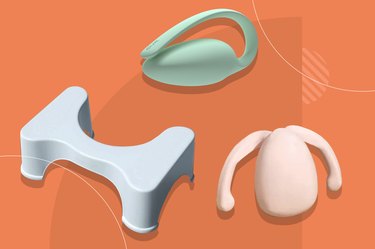
Issues like urinary incontinence (i.e. bladder leakage), constipation and pelvic pain aren't just frustrating — they may also be a sign of dysfunction in the pelvic floor, according to Harvard Health Publishing.
Your pelvic floor is the system of muscles and connective tissues that support your pelvic organs, like your bladder, bowel and sex organs.
Video of the Day
Video of the Day
Injury and aging can cause a tight or weak pelvic floor, which can lead to a host of health issues, such as urinary incontinence, constipation, fecal incontinence, pelvic pain, pain during sex and pelvic organ prolapse, according to the Cleveland Clinic.
Kegel exercises often come to mind when we think about pelvic floor health, but there's more to the story.
Here's how your pelvic floor health is connected to the way you breathe and how to start a diaphragmatic breathing practice to help relieve pelvic issues.
Why Shallow Breathing Is a Hazard for Pelvic Floor Health
Just above the pelvic floor is the abdomen, and our diaphragm sits just at the top of the abdomen underneath the rib cage. The diaphragm is a dome-shaped muscle that plays an important role in breathing.
When we take a deep inhale, the lungs fill with air and the diaphragm is pushed down. This downward movement compresses the abdominal organs, increasing "intra-abdominal pressure" (IAP), which then forces the pelvic floor to lengthen and relax as it moves downward as well, says Judith Meer, DPT, an orthopedist and doctor of physical therapy specializing in pelvic health.
When we exhale, our diaphragm moves back up, and this causes our pelvic floor muscles to contract and shorten, Meer adds.
Unfortunately, many of us aren't taking deep breaths into the diaphragm regularly, which can wreak havoc on our pelvic floor health. "Shallow, short breaths deprive our diaphragm of the ability to move through its full range of motion," Meer says.
Without proper movement, the muscles in your pelvic floor can set your entire muscular system off balance. "Shallow breathing may keep the pelvic floor in a state of over-activity, or excessive tension," says Rachel Parrotta, DPT, a doctor of physical therapy specializing in pelvic health.
"Ultimately, a pelvic floor that is tight, weak or uncoordinated can't be an effective partner [to other muscle groups] in performing activities that require stability and strength, which means [those groups] need to pick up the slack," Meer says. "These compensations will really add up over time."
With chronic shallow breathing, you may notice symptoms of pelvic floor dysfunction. "Pelvic floor muscle over-activity or tension may play a role in symptoms such as pelvic pain, dyspareunia (pain with sexual activity), urinary urgency and frequency and coccyx pain," Parrotta says.
Benefits of Diaphragmatic Breathing for Pelvic Floor Health
The relationship between the diaphragm and the pelvic floor is clear, and researchers are now studying how changing the way we breathe can provide benefits.
In a small pilot study, diaphragmatic breathing techniques were shown to be an effective alternative to pelvic floor exercises for urinary incontinence, according to results in the January 2022 issue of the Journal of Bodywork and Movement Therapies.
Diaphragmatic breathing can also help with digestive issues, according to University of Michigan Health. That's because it massages digestive organs (through IAP) like the intestines and stomach, which can reduce abdominal pain, urgency, bloating and constipation.
Breathing diaphragmatically also activates the parasympathetic nervous system, or your "rest and digest" state, which may help alleviate issues like diarrhea, per University of Michigan Health.
"Diaphragmatic breathing — more specifically, 360-degree breathing (a more thorough use of respiratory muscle potential) — is key to optimizing pelvic health," Meer says. "It increases blood flow to the pelvic muscles, helps with their ability to maintain tone and to tighten and lengthen effectively."
A Diaphragmatic Breathing Exercise for Pelvic Floor Health
Luckily, beginning a daily breathing practice for your pelvic floor health can be simple. Use Parotta's diaphragmatic breathing exercise to start feeling relief today:
- Place your hands on the bottom portion of your rib cage. Slide your hands slightly away from each other.
- On an inhale, breathe into your hands, which should then slide toward the sides of your rib cage.
- On your exhale, allow your rib cage to return back to the starting position.
- Instead of focusing on your belly with this breathing exercise, try to focus on expanding your rib cage 360 degrees, as if you were opening and closing an umbrella.
- Repeat for 10 breaths.
"You can repeat this exercise with up to three sets of 10 breaths per day," Parotta says.
When to See a PT About Pelvic Floor Issues
There are a few signs and symptoms of pelvic floor dysfunction you shouldn't ignore.
"Common signs of pelvic floor muscle dysfunction may include genital pain (vulvar, penile, testicular pain), rectal pain, coccyx pain, constipation, dyspareunia (pain with sexual activity), vaginismus (inability to tolerate vaginal penetration), urinary urgency and frequency, incontinence and pelvic pressure or prolapse," Parotta says.
"If a person is experiencing these symptoms, even if they are mild, they should see their physician to rule out infection or other health issues. Once other conditions are ruled out, pelvic floor muscle dysfunction is a likely culprit, and the person should reach out to a physical therapist who specializes in pelvic floor muscle conditions."
And if you've been dealing with such issues and have not been given a referral for pelvic floor physical therapy, don't be afraid to ask your doctor for one.
"Anyone who has had their concerns dismissed or downplayed by their gynecologist, urologist, colorectal doctor or other specialty often find that the neuromuscular expertise and whole body holistic approach of a pelvic physical therapist is a refreshing and welcome change," Meer says.
She adds: "A physical therapist specialized in pelvic health is ideally positioned to address these issues with you. We deeply care about educating and supporting people of all ages and across the gender spectrum on their journey towards better pelvic health."
Was this article helpful?
150 Characters Max
0/150
Thank you for sharing!
Thank you for your feedback!
Is this an emergency? If you are experiencing serious medical symptoms, please see the National Library of Medicine’s list of signs you need emergency medical attention or call 911.


